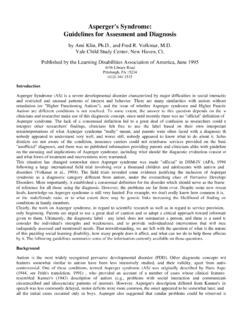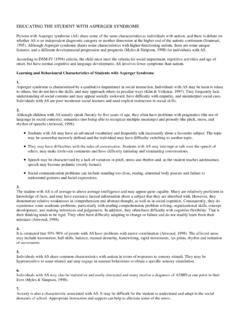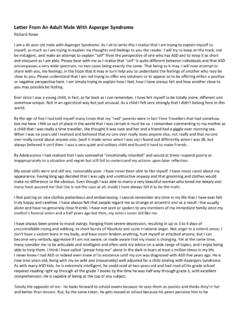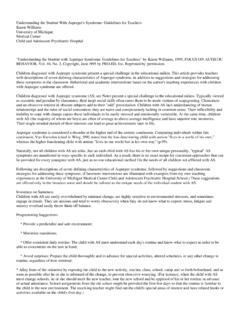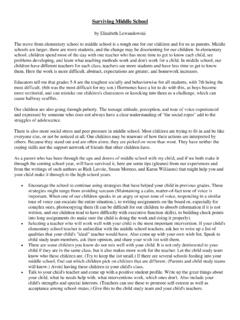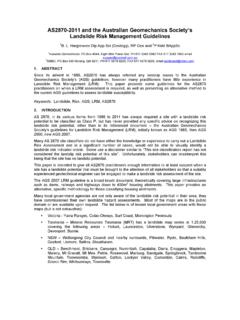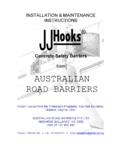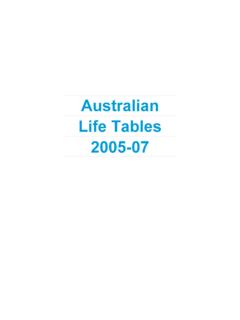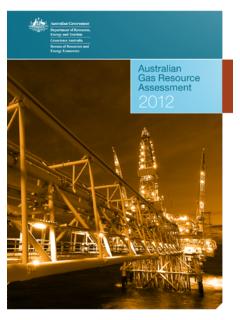Transcription of THE AUSTRALIAN SCALE FOR ASPERGER'S …
1 THE AUSTRALIAN SCALE FOR ASPERGER'S SYNDROME. Garnett and Attwood The AUSTRALIAN SCALE For ASPERGER'S Syndrome ( ) is reprinted on the ASPEN website with the permission of Tony Attwood, PhD. This is excerpted from his extremely informative and easy-to-read book ASPERGER'S SYNDROME: A. GUIDE FOR PARENTS AND PROFESSIONALS. The following questionnaire is designed to identify behaviours and abilities indicative of ASPERGER'S Syndrome in children during their primary school years. This is the age at which the unusual pattern of behaviour and abilities is most conspicuous. Each question or statement has a rating SCALE with 0 as the ordinary level expected of a child of that age.
2 A. SOCIAL AND EMOTIONAL ABILITIES. Rarely Frequently 1. Does the child lack an understanding of how to play with other children? For example, unaware of the unwritten rules of social play? 0. 1. 2. 3. 4. 5. 6. 2. When free to play with other children, such as school lunchtime, does the child avoid social contact with them? For example, finds a secluded place or goes to the library. 0. 1. 2. 3. 4. 5. 6. 3. Does the child appear unaware of social conventions or codes of conduct and make inappropriate actions and comments? For example, making a personal comment to someone but the child seems unaware of how the comment could offend.
3 0. 1. 2. 3. 4. 5. 6. 4. Does the child lack empathy, ie. the intuitive understanding of another person's feelings? For example, not realising an apology would help the other person feel better. 0. 1. 2. 3. 4. 5. 6. 5. Does the child seem to expect other people to know their thoughts, experiences and opinions? For example, not realising you could not know about something because you were not with the child at the time. 0. 1. 2. 3. 4. 5. 6. 6. Does the child need an excessive amount of reassurance, especially if things are changed or go wrong? 0. 1. 2. 3. 4. 5. 6. 7. Does the child lack subtlety in their expression of emotion?
4 For example, the child shows distress or affection out of proportion to the situation. 0. 1. 2. 3. 4. 5. 6. 8. Does the child lack precision in their expression of emotion? For example, not understanding the levels of emotional expression appropriate for different people. 0. 1. 2. 3. 4. 5. 6. 9. Is the child not interested in participating in competitive sports, games and activities. 0 means the child enjoys competitive sports. 0. 1. 2. 3. 4. 5. 6. 10. Is the child indifferent to peer pressure? 0 means the child follows crazes. For example, does not follow the latest craze in toys or clothes. 0. 1. 2. 3. 4. 5. 6.
5 B. COMMUNICATION SKILLS. Rarely Frequently 11. Does the child take a literal interpretation of comments? For example, is confused by phrases such as "pull your socks up," "looks can kill" or "hop on the scales.". 0. 1. 2. 3. 4. 5. 6. 12. Does the child have an unusual tone of voice? For example, the child seems to have a "foreign" accent or monotone that lacks emphasis on key words. 0. 1. 2. 3. 4. 5. 6. 14. When in a conversation, does the child tend to use less eye contact than you would expect? 0. 1. 2. 3. 4. 5. 6. 15. Is the child's speech over-precise or pedantic? For example, talks in a formal way or like a walking dictionary.
6 0. 1. 2. 3. 4. 5. 6. 16. Does the child have problems repairing a conversation? For example, when the child is confused, he or she does not ask for clarification but simply switches to a familiar topic, or takes ages to think of a reply. 0. 1. 2. 3. 4. 5. 6. C. COGNITIVE SKILLS. Rarely Frequently 17. Does the child read books primarily for information, not seeming to be interested in fictional works? For example, being an avid reader of encyclopaedias and science books but not keen on adventure stories. 0. 1. 2. 3. 4. 5. 6. 18. Does the child have an exceptional long-term memory for events and facts? For example, remembering the neighbour's car registration of several years ago, or clearly recalling scenes that happened many years ago.
7 0. 1. 2. 3. 4. 5. 6. 19. Does the child lack social imaginative play? For example, other children are not included in the child's imaginary games or the child is confused by the pretend games of other children. 0. 1. 2. 3. 4. 5. 6. D. SPECIFIC INTERESTS. Rarely Frequently 20. Is the child fascinated by a particular topic and avidly collects information or statistics on that interest? For example, the child becomes a walking encyclopaedia of knowledge on vehicles, maps or league tables. 0. 1. 2. 3. 4. 5. 6. 21. Does the child become unduly upset by changes in routine or expectation? For example, is distressed by going to school by a different route.
8 0. 1. 2. 3. 4. 5. 6. 22. Does the child develop elaborate routines or rituals that must be completed? For example, lining up toys before going to bed. 0. 1. 2. 3. 4. 5. 6. E. MOVEMENT SKILLS. Rarely Frequently 23. Does the child have poor motor coordination? For example, is not skilled at catching a ball. 0. 1. 2. 3. 4. 5. 6. 24. Does the child have an odd gait when running? F. OTHER CHARACTERISTICS. For this section, tick whether the child has shown any of the following characteristics: (a) Unusual fear or distress due to: ordinary sound, electrical appliances_____. light touch on skin or scalp_____. wearing particular items of clothing_____.
9 Unexpected noises_____. seeing certain objects_____. noisy, crowded places, supermarkets_____. (b) A tendency to flap or rock when excited or distressed _____. (c) A lack of sensitivity to low levels of pain_____. (d) Late in acquiring speech_____. (e) Unusual facial grimaces or tics_____. If the answer is yes to the majority of the questions in the SCALE , and the rating was between two and six ( conspicuously above the normal range), it does not automatically imply the child has ASPERGER'S Syndrome. However, it is a possiblity and a referral for a diagnostic assessment is warranted.
